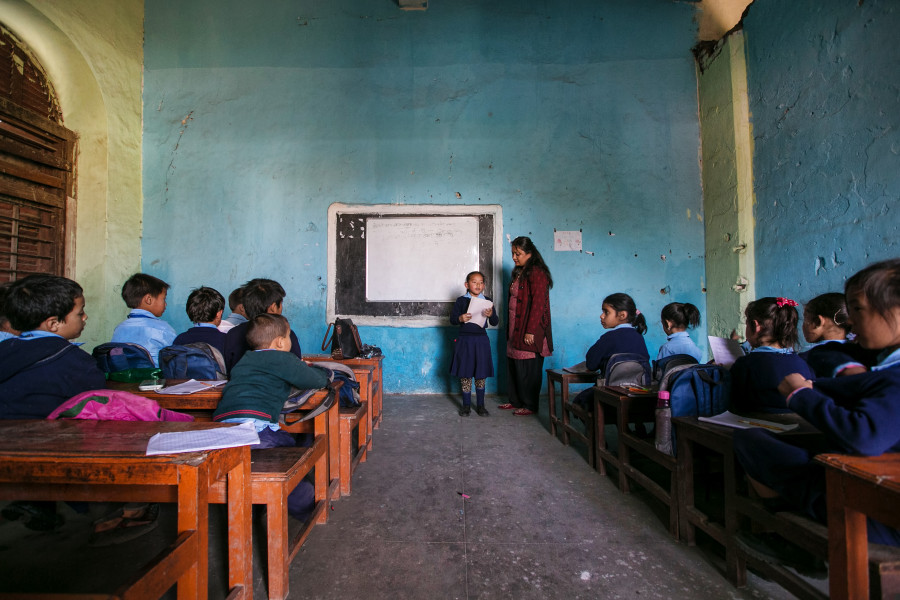Columns
Educating linguistic minority children
Nepal’s educational development is impacted mainly by a lack of opportunities for multilingual education.
Puskar Joshi
Why is it a colossal task to ensure universal primary education for linguistic minority children in Nepal?
Schooling historically disadvantaged students has never been an easy task anywhere. Human Rights Watch says more than 260 million children were out of school worldwide in 2019. The United Nations Children’s Fund (UNICEF) claims more girls than boys in areas affected by conflicts have not attended school because of their historically poor conditions. Presumably, none of these children belong to privileged backgrounds.
With a history of armed conflict that lasted until the first decade of the 21st century, Nepal has struggled to admit historically disadvantaged children to school more than ever. As a result, the country has faced even more challenging experiences in achieving the “Education for All” (EFA) goals. Among the country’s circa 30 million population, UNICEF estimates 770,000 children aged between five and 12 have never been to school.
What’s the issue?
Since the beginning of mass education in the early 1950s, Nepal persistently imposed a one-nation, one national-language schooling policy irrespective of the country’s linguistic diversity. That made schools distant and unfriendly spaces for ethnic and indigenous children. Although the EFA programme accelerated school enrollment quite recently, reports from the World Bank suggest no substantial gains in educational equity and success among minority children. This is not a good sign for Nepal in terms of development.
Why does it matter?
Because it is evolving, Nepal’s democracy is under critical test. For the institutionalisation of democracy, the country must work to fulfil the aspirations of at least the majority population for whom Nepali is not their first language (also L1, mother tongue, home language, or heritage language). Indeed, any political system that overlooks people’s concerns is undemocratic and lacks the legitimacy to remain in power.
Generally, when there is a system change for a more open, inclusive, pluralistic, and democratic society—as in the present context of Nepal—people look for leadership ready to commit itself to fulfil people’s growing aspirations to transform their lives. Unfortunately, those holding political, bureaucratic, and academic positions in Nepal are primarily groups of people who have difficulty embracing change. That might explain why the country’s current medium of instruction policy has remained intact even after the government promulgated a more democratic constitution, the Constitution of Nepal 2015, which largely favours education in the mother tongue. After all, change cannot take place without putting words into action. We cannot expect change if we don’t shake up the system plagued by outdated practices, attitudes, behaviours, and mindsets.
What’s going on?
Nepal has continued to prioritise the historically dominant Nepali and English languages as the mediums of instruction. But none of these languages belong to the majority of the country’s population, who speak one or more out of 123 living languages. As a matter of fact, Nepali is the first language for only 44.6 percent of the population, while English is preferred mainly by elites and those with global mindsets. Undoubtedly, education in dual languages matters very little to a large segment of the country’s population. Ironically, those promoting English have no vital information on the detrimental consequences of schooling in a foreign language.
The continued imposition of the Nepali and English languages as the mediums of instruction tells why Nepali schools are detached from or even foreign to most of the country’s schoolchildren. Although instruction in Nepali is desirable because of its second language or lingua franca status, it cannot be the sole language of instruction in all local contexts. That means distinction must be made on the Nepali language as a suitable medium of education based on different linguistic contexts. Since English is a foreign language in Nepal, it is far removed from most students’ lives; hence, it should be disqualified as a medium of instruction both for fairness and practicality.
That said, there is little value in questioning the merits of English. And there’s no way one can underestimate the power of English to influence our lives in the age of media, science, and technology, which would not have flourished as much as today without this language. Yet, it is essential to acknowledge that there are even better ways of enhancing the instruction of English than we might know. As Professor Mary A Stewart states, students do better in English or other foreign languages if they have the opportunities for bilingual (also multilingual) education, which is teaching in more than one language with emphasis on the mother tongue.
There are other reasons to consider multilingual schooling. First, as scholars stress, it helps pupils’ personality development, namely self-esteem elevation and identity consciousness. Evidence shows that mother tongue-based education decreases school dropout and enhances school success, especially for students from minority language backgrounds. Research also indicates the psychological, socio-economic, and cognitive benefits of bilingual or multilingual education. What all these findings allude to are the multiple advantages of home language schooling, including the learning of a second or foreign language more effectively and efficiently; hence a great alternative to the medium of instruction policy for Nepal.
Second, multilingual schooling is a measure of government transparency and accountability. As citizens of a democratic country, Nepali people have the right to see whether public policy, like the language policy, has been honestly implemented as dictated by the constitution. They also have the right to know the actors, their actions, and how they are represented and treated.
Since Nepal’s unification, our political power has rested in the hands of Nepali-speaking groups or individuals who have refused to delegate authority to the marginalised majority. The imposition of Nepali and English as the mediums of instruction and the denial of recognising minority languages for a long time substantiates dominant groups’ monolingual habitus (the preference for the dominant language).
Also, because international donors substantially support Nepal’s educational expenditure, the global north’s influence on the policy is enormous. The privatisation of education in Nepal, which began in the early 1990s, is an example of a neo-liberal policy preferred by international partners. Because neo-liberal policy emphasises globalisation, economic liberalism, and the government’s non-interference in the private sector, Nepal’s rulers often have weaponised neo-liberalism to deflect the responsibility for controlling the influence of English and implementing a more favourable multilingual schooling policy.
Other contradictions
Last year, I spoke with several language policy actors, experts, and language activists from mainly marginalised groups to understand their perspectives on the country’s current language in education policy. What I learned from those conversations was that linguistic minority groups’ dissatisfaction was associated with the political and bureaucratic reluctance to and lack of strategy for the implementation of multilingual schooling. I also learned a lot of conceptual misunderstandings among policy actors, experts, and language activists, who largely viewed mother tongue-based education as teaching local languages as subjects rather than using the languages to teach content (concepts, information, details, etc.). But scholarship is clear about the difference between the medium of instruction and teaching languages as subjects. The latter is not necessarily helpful in promoting and revitalising endangered languages. Specifically, multilingual education must focus on teaching the content in home language.
The conversations were also important to interrogate the disconnection between policy, practice, and research. I was astounded to find out that some of the participants lacked awareness of the remarkable contributions of researchers in the field who have been great assets in drawing international attention to Nepal's multilingual education development, knowledge sharing, and disseminating the success narratives of multilingual education at local levels. Still troubling is the lack of comprehension of the benefits of research for the success and sustainability of educational interventions, which has been affected by the lack of field-based research.
Afterword
To sum up, Nepal’s educational development is impacted mainly by the lack of opportunities for multilingual education. Unless the Nepal government is ready to enforce the medium of instruction in local languages, it is challenging to boost the enrollment of linguistic minority students and retain them in school until they complete universal primary education. And as there exists a lack of conceptual clarity on what constitutes multilingual education and the recognition of the role of research in the success and sustainability of mother tongue-based education, the goal to achieve EFA seems unfulfilled any time soon.




 9.12°C Kathmandu
9.12°C Kathmandu















